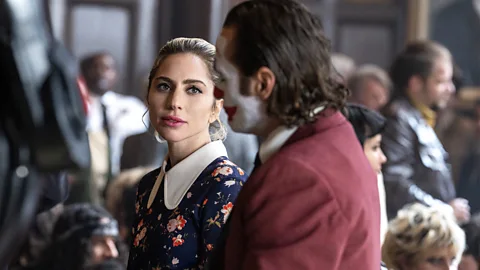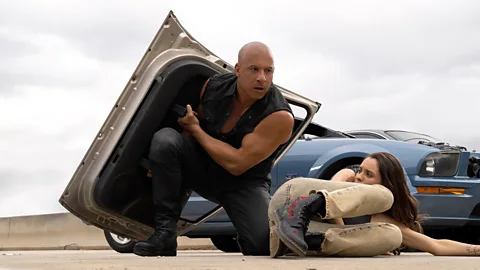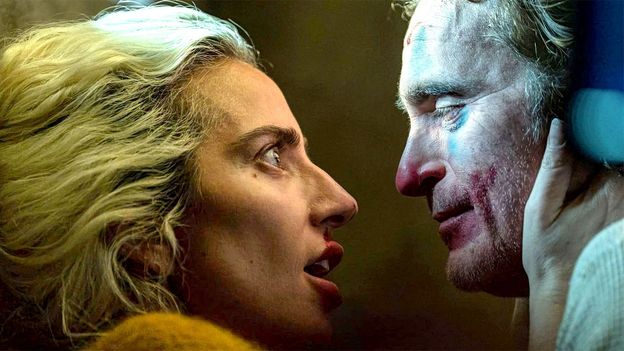 Alamy
AlamyThe comic book sequel has bombed at the box office – but what makes its performance even more catastrophic is its astronomical cost, estimated to be more than three times the original.
It’s one of those debacles that must have seemed like a good idea at the time. In 2019, Todd Phillips’s Joker rewrote the superhero rulebook by putting Batman’s arch-enemy into a dingy urban psychodrama. The film was a commercial and critical smash, and Joaquin Phoenix won an Oscar for playing Arthur Fleck, aka The Joker, so it made sense that Phillips and Phoenix should reunite for a sequel. And when it was announced that Joker: Folie à Deux would be a musical co-starring Lady Gaga as Lee Quinzel, aka Harley Quinn, that didn’t seem like such a bad idea, either. Once again, Phillips was dropping DC comics’ characters into an unexpected genre.
This time, it hasn’t paid off. Joker: Folie à Deux made around $40m (£31m) in its opening weekend in the US, which is less than half of what the first film raked in over the same period. In Deadline, Antonio D’Alessandro called it “one of the lowest sequel openings in memory to a major franchise film based on a comic-book”, adding the damning comparison that it has done even worse at this stage than last year’s Marvel flop, The Marvels.
 Warner Bros
Warner BrosFor those of us who saw Folie à Deux when it premiered at the Venice Film Festival last month, this catastrophic result isn’t a huge surprise, as Phillips and his team appeared intent on disappointing and even mocking fans of the original Joker: rather than showing Arthur cutting a bloody swathe through Gotham city’s plutocrats, the new film asserts that he is a pathetic shell of a man whom only the deluded would admire.
What’s more, Phillips makes this assertion in the most self-indulgent, navel-gazing fashion. Most sequels either advance the story told by their predecessor, or retell that story with a few variations, but this one spends more than two hours reminiscing about that story instead. Whether Arthur’s past crimes are being discussed by his therapist and an interviewer in Arkham Asylum, or by lawyers and witnesses in Gotham city’s courtroom, scene after scene is devoted to people talking about what happened in a five-year-old film. These debates may have been interesting in a magazine article, a spin-off graphic novel, or a chat in the pub, but they’re not the stuff of a $200m blockbuster.
Yes, you read that correctly. Folie à Deux is reported by different outlets to have cost between $190m (£145m) and $200m (£153m), an almost unbelievable leap up from the first film’s $65m budget. And that’s the real reason why its opening weekend is so calamitous. If it had cost as much as Joker, or even twice as much, its box-office takings might not have looked so paltry. But around three times as much? Folie à Deux is a folly.
Hollywood’s spiralling costs
Not that this is the craziest amount of money spent on a Hollywood film in recent times. Last year an article in the Daily Telegraph listed some of the astronomically expensive blockbusters that were coming out, including Fast X ($340m, £260m), Indiana Jones and the Dial of Destiny ($300m, £229m), Mission: Impossible – Dead Reckoning Part One ($290m, £222m), and The Flash ($220m, £168m). Stack the marketing costs on top of those figures, and they all had to perform phenomenally well to break even; in the end, it is estimated that none of these films made significant profit, and Indiana Jones and The Flash made significant losses.
But the article placed much of the blame for these films’ monumental costs on the visual effects, especially those visual effects that had to be finished at top speed to suit a studio’s set-in-stone release schedule. And, whatever you thought of them, each of those films looked like a bona fide blockbuster. In terms of the star-studded casts, the global locations, the elaborate stunts, and, yes, the visual effects, they were all so spectacular that “you could see the money on the screen”, as the expression goes. That’s not the case with Phillips’ dingy, small-scale courtroom drama. Indeed, there aren’t many other Hollywood films in which the money is so shockingly not on the screen.
 Alamy
AlamyFolie à Deux doesn’t have big action set pieces. It doesn’t have jaw-dropping effects. It’s true that Phoenix and Gaga don’t work for free, but neither of them is a film-industry megastar. And it’s true that there are song and dance numbers, but these pay tribute to old musicals and TV specials, so they’re not especially lavish. A detailed breakdown of where all the money went would be much more gripping to read than the film’s screenplay.
Ultimately, the whole enterprise starts to feel like a weirdly postmodern joke at Hollywood’s expense. In Joker, Arthur attacked Gotham’s wealthiest people, and he railed against the smugness of the entertainment industry; this time around the over-spending and underperforming of the film itself have achieved the same goal. Folie à Deux has burnt a mountain of studio cash in a way that’s reminiscent of Heath Ledger’s Joker setting fire to a ziggurat of hundred-dollar bills in The Dark Knight.
It might have been nobler if Phillips had spent all those millions on something worthwhile. When Cord Jefferson won the Oscar for best adapted screenplay for American Fiction in March, he made a point in his acceptance speech that now feels like a prescient critique of the Joker: Folie à Deux situation: “I understand that this is a risk-averse industry, I get it, but $200 million movies are also a risk,” he said. “And it doesn’t always work out, but you take the risk, anyway. And instead of making one $200 million movie, try making 10 $20 million movies, or 50 $4 million movies.” If studio executives weren’t listening to Jefferson then, maybe they’ll listen now.


